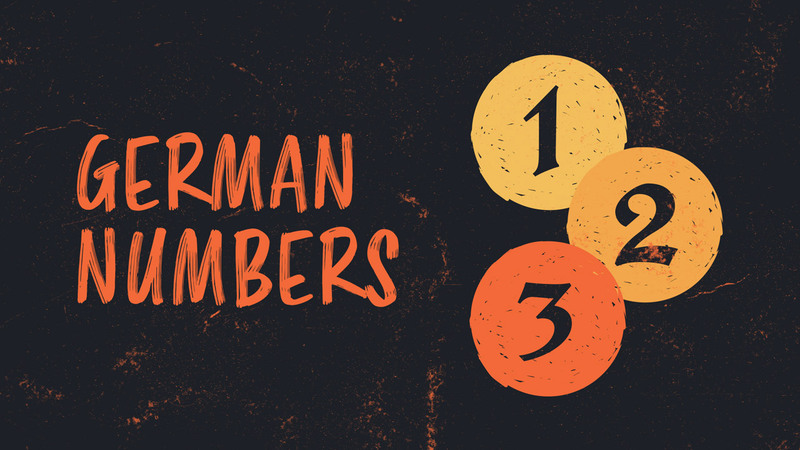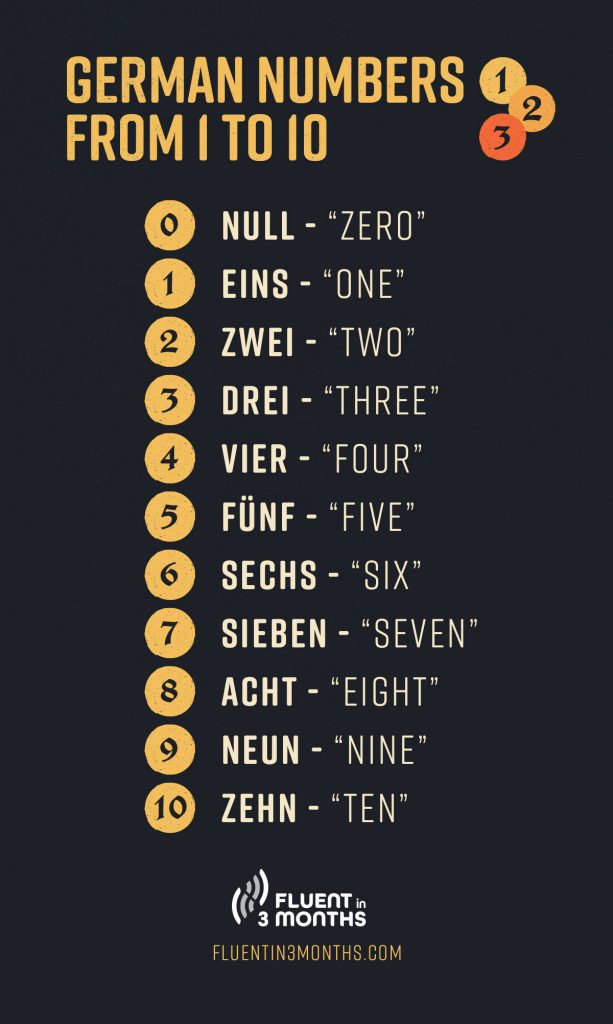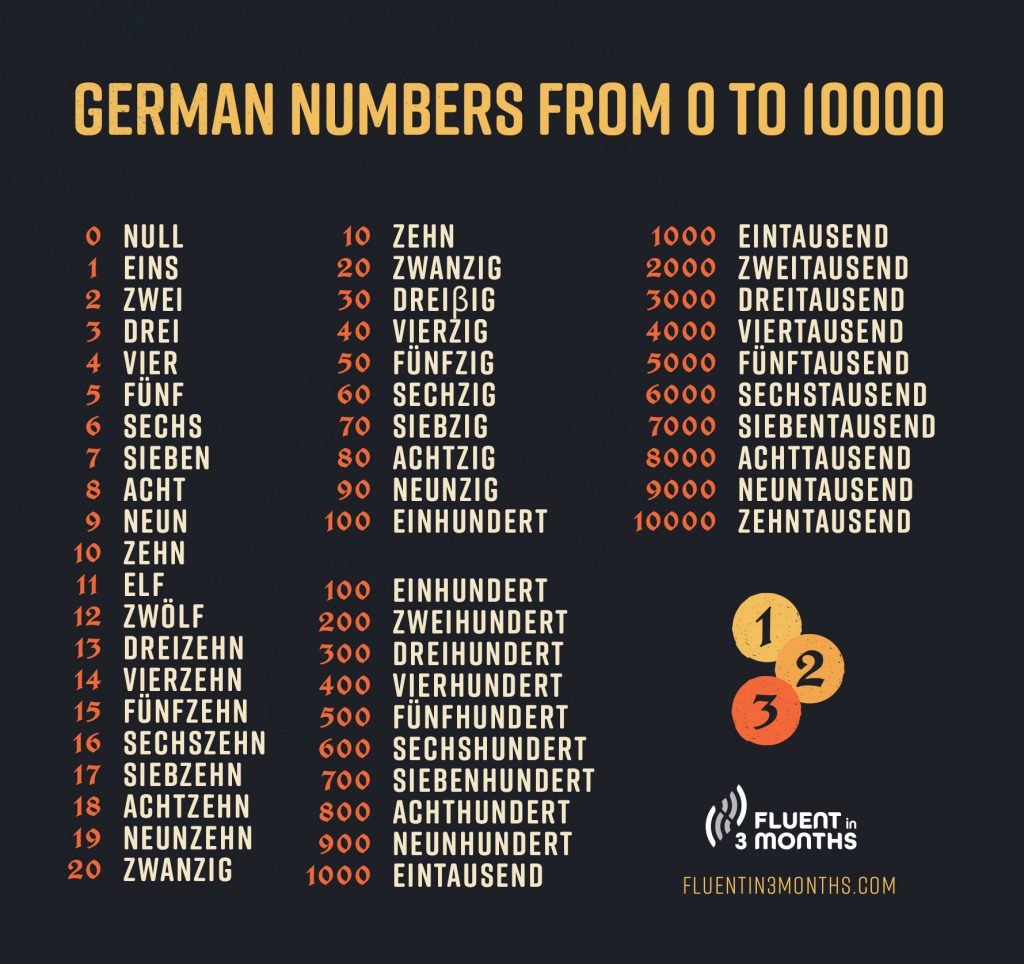German Numbers: Learn To Count From 0 to 1,000 in German
Do you want to learn how to count from 0-100 in German, and find out more about German numbers?
In this article, I want to share with you how to learn, remember, and use German numbers with you.
Table of contents
- German Numbers from 1-100
- Learn the German Numbers 1-10
- Learn the German Numbers 11-20
- Learn the German Multiples of 10
- German For “One”: Ein, Eins, Eine, Einen, Eines, Einer or Einem ?
- How To Count From 100 to 1,000 In German
- How To Count From 1,000 to 10,000 in German
- German Numbers: 10,000 And Beyond
- Remember the German Numbers with This Language Hack
- The Etymology of German Numbers
- German Numbers You Can Count On…
Before we get into the article, if you are interested in learning German yourself, you should check out my absolute favourite resource for learning German, GermanPod101.
Every time I refresh my German, this has been by far my favourite resource, since it’s a podcast style learning resource that covers many aspects of the language much better than traditional courses do.
It also tackles the issue of listening comprehension better than literally anything else out there, since its catalogue of lessons eases you in with simple lessons at first that get progressively harder, and you can listen to them for a huge range of topics better suited to your hobbies and interests.
They have a free option for anyone who wants to test them out, based on just their limited recent episodes, but exclusively for Fi3M readers, you can get 20% off if you sign-up for any of their subscriptions, which allow you to access their full catalog of many hundreds of lessons, using the code FLUENT3.
I highly recommend this to all German learners!!
German Numbers from 1-100
Let’s start with the basics. Below is a table of the German numbers from zero to 100. Take a few minutes read through it, then I’ll give you some tips to help you remember it all:
| 0 | Null |
| 1 | Eins |
| 2 | Zwei |
| 3 | Drei |
| 4 | Vier |
| 5 | Fünf |
| 6 | Sechs |
| 7 | Sieben |
| 8 | Acht |
| 9 | Neun |
| 10 | Zehn |
| 11 | Elf |
| 12 | Zwölf |
| 13 | Dreizehn |
| 14 | Vierzehn |
| 15 | Fünfzehn |
| 16 | Sechszehn |
| 17 | Siebzehn |
| 18 | Achtzehn |
| 19 | Neunzehn |
| 20 | Zwanzig |
| 21 | Einundzwanzig |
| 22 | Zweiundzwanzig |
| 23 | Dreiundzwanzig |
| 24 | Vierundzwanzig |
| 25 | Fünfundzwanzig |
| 26 | Sechsundzwanzig |
| 27 | Siebenundzwanzig |
| 28 | Achtundzwanzig |
| 29 | Neunundzwanzig |
| 30 | Dreiβig |
| 31 | Einunddreiβig |
| 32 | Zweiunddreiβig |
| 33 | Dreiunddreiβig |
| 34 | Vierunddreiβig |
| 35 | Fünfunddreiβig |
| 36 | Sechsunddreiβig |
| 37 | Siebenunddreiβig |
| 38 | Achtunddreiβig |
| 39 | Neununddreiβig |
| 40 | Vierzig |
| 41 | Einundvierzig |
| 42 | Zweiundvierzig |
| 43 | Dreiundvierzig |
| 44 | Vierundvierzig |
| 45 | Fünfundvierzig |
| 46 | Sechsundvierzig |
| 47 | Siebenundvierzig |
| 48 | Achtundvierzig |
| 49 | Neunundvierzig |
| 50 | Fünfzig |
| 51 | Einundfünfzig |
| 52 | Zweiundfünfzig |
| 53 | Dreiundfünfzig |
| 54 | Vierundfünfzig |
| 55 | Fünfundfünfzig |
| 56 | Sechsundfünfzig |
| 57 | Siebenundfünfzig |
| 58 | Achtundfünfzig |
| 59 | Neunundfünfzig |
| 60 | Sechzig |
| 61 | Einundsechzig |
| 62 | Zweiundsechzig |
| 63 | Dreiundsechzig |
| 64 | Vierundsechzig |
| 65 | Fünfundsechzig |
| 66 | Sechsundsechzig |
| 67 | Siebenundsechzig |
| 68 | Achtundsechzig |
| 69 | Neunundsechzig |
| 70 | Siebzig |
| 71 | Einundsiebzig |
| 72 | Zweiundsiebzig |
| 73 | Dreiundsiebzig |
| 74 | Vierundsiebzig |
| 75 | Fünfundsiebzig |
| 76 | Sechsundsiebzig |
| 77 | Siebenundsiebzig |
| 78 | Achtundsiebzig |
| 79 | Neunundsiebzig |
| 80 | Achtzig |
| 81 | Einundachtzig |
| 82 | Zweiundachtzig |
| 83 | Dreiundachtzig |
| 84 | Vierundachtzig |
| 85 | Fünfundachtzig |
| 86 | Sechsundachtzig |
| 87 | Siebenundachtzig |
| 88 | Achtundachtzig |
| 89 | Neunundachtzig |
| 90 | Neunzig |
| 91 | Einundneunzig |
| 92 | Zweiundneunzig |
| 93 | Dreiundneunzig |
| 94 | Vierundneunzig |
| 95 | Fünfundneunzig |
| 96 | Sechsundneunzig |
| 97 | Siebenundneunzig |
| 98 | Achtundneunzig |
| 99 | Neunundneunzig |
| 100 | Einhundert |
Seeing it all in one big block can be a little overwhelming, right? Well, don’t worry. Using the simple tips and language hacks below, you’ll be able to remember all of this information with little effort.
Learn the German Numbers 1-10
The German numbers 1-10 are:
- Ein – “One”
- Zwei – “Two”
- Drei – “Three”
- Vier – “Four”
- Fünf – “Five”
- Sechs – “Six”
- Sieben – “Seven”
- Acht – “Eight”
- Neun – “Nine”
- Zehn – “Ten”
There are no rules for these numbers – though I’ll share a simple trick for memorising them later in the article. And it is important to remember these numbers, as they occur, in one form or another, in every number you’ll use when counting.
For example, just as “eight” is in “eighteen”, “twenty-eight”, “eighty” and “eighthundred”, the same can be said for acht (“eight”) in German. “Achtzehn”, “achtundzwanzig”,”achtzig” and “achthundert”.
Learn the German Numbers 11-20
Elf (“eleven”) and zwölf (“twelve”) also don’t follow a pattern. You’ll just have to learn these by heart.
For the other German numbers between 13 and 19 you take the first four letters of the number between three and nine (like the rule above) and add the word zehn or ten at the end: dreizehn (“thirteen”), vierzehn (“fourteen”), fünfzehn (“fifteen”), and so on.
Learn the German Multiples of 10
Between forty and ninety, all of these numbers are regular. They take the first four letters of the number between one and ten and add the word “zig” to the end of it.
Vierzig (“forty”), fünfzig (“fifty”), sechzig (“sixty”), siebzig (“seventy”), achtzig (“eighty”), neunzig (“ninety”).
Twenty and thirty are exceptions. Twenty takes the form zwanzig, and thirty is dreiiβig.
Once you’ve learned all of these you can begin to fill in the numbers with a simple formula.
All of the numbers larger than twenty follow the same pattern. The second number is said at the start. Let me explain that a bit more:
- In English you would say “thirty-four”. The biggest number is said first, followed by the smallest number. As if you’re reading the number left to right. In German it’s the other way around.
- In German you would say, “four and thirty” or vierunddreiβig. The four comes first, followed by the thirty.
- Although I can’t tell you why this happens, I can tell you that it’s regular and all of these numbers in German follow this pattern.
This swapping around can take some getting used to so take some time to practice them. When it comes to writing these, many German children are taught to write the second number first, the same way as when it’s spoken, then place the first number before it.
Practicing this may help you understand it too.
Also don’t forget that:
- Zero = Null (As in null and void)
- 100 = Einhundert (This is an easy one to remember!)
By using these tips and language hacks you should have no trouble mastering the German numbers 1 to 100.
German For “One”: Ein, Eins, Eine, Einen, Eines, Einer or Einem?
The number one in German is the only number that needs to be modified.
In English, we have three words for “one”. We have the number one itself, or we use “a” or “an” to express we only have one of something.
- “I have one brother.”
- “I have a sister.”
- “I have an apple.”
In German these three words are expressed using variations of ein and eins.
When you’re counting the quantity of something – like how many people are in a group – you’ll always use the “eins” form of the word, which is the number one itself, as you can see in the table at the start of this article.
However when you’re referring to anything else you’ll use the “ein” form of the word and its case-based variations. Such as:
Nominative:
- Masculine: ein Bruder (“a Brother”)
- Neutral: ein Auto (“a Car”)
- Feminine: eine Schwester (“a Sister”)
Accusative:
- Masculine: einen Bruder
- Neutral: ein Auto
- Feminine: eine Schwester
Dative:
- Masculine: einem Bruder
- Neutral: einem Auto
- Feminine: einer Schwester
Genitive:
- Masculine: eines Bruders
- Neutral: eines Autos
- Feminine: einer Schwester
Explaining each of these in-depth is a little beyond the scope of this article. But remember that when you’re counting, you use numbers. When you’re talking to someone, you’ll use ein and its variations.
Other numbers like “two” in German or “three” in German don’t need to be modified and stay the same throughout.
Related learning: How to Use the Dative Case in German – In-Depth Guide [with Charts]
How To Count From 100 to 1,000 In German
The rule for counting in the hundreds is exactly the same as in English. You take the number from one to nine and add the word hundert (“hundred”) to the end of it.
Here’s a table to show you what I mean:
| 100 | Einhundert |
| 200 | Zweihundert |
| 300 | Dreihundert |
| 400 | Vierhundert |
| 500 | Fünfhundert |
| 600 | Sechshundert |
| 700 | Siebenhundert |
| 800 | Achthundert |
| 900 | Neunhundert |
| 1000 | Eintausend |
Filling in the gaps between these numbers is relatively simple too. There are just a few things to remember:
- You always say the hundred number first.
- Between 100 and 119 you say it the same way you would in English. So 101 (“one-hundred and one”) becomes einhundertundeins.
- Once you get higher than 20 the number-swapping rule comes into effect, but only for the two digit numbers. That means 176 (“one-hundred and seventy six”) becomes einhundertsechsundsiebzig.
These rules apply throughout all the hundreds.
How To Count From 1,000 to 10,000 in German
You’ve already learned the hardest parts of counting in German. From here on out it’s so similar to English you don’t need to remember much.
The word for thousand in German is tausend, which is said like you’re saying the English word “thousands” in a German accent.
Then the thousands themselves follow work the same as you just saw in the 100’s, but with the word tausend added to the end:
| 1000 | Eintausend |
| 2000 | Zweitausend |
| 3000 | Dreitausend |
| 4000 | Viertausend |
| 5000 | Fünftausend |
| 6000 | Sechstausend |
| 7000 | Siebentausend |
| 8000 | Achttausend |
| 9000 | Neuntausend |
| 10000 | Zehntausend |
When you start adding hundreds into the mix, the rules of the 100’s you just read still apply. You only change the two-digit number – like 43 – around, the rest go in order.
German Numbers: 10,000 And Beyond
For the numbers in the 10,000’s you’re going to follow the two-digit number rules. In succession, these numbers follow on in multiples of ten: zehntausend, zwanzigtausend, dreiβigtausend and so on.
When the numbers change to have a second digit, like 87, this would then become siebenundachtzigtausend (“seven and eighty-thousand”). This can become quite a mouthful when the number is 87,787 which would be siebenundachtzigtausendsiebenhundertsiebenundachtzig.
When you reach the 100,000’s you can then apply the rules for this, but with 100’s numbers. So 100,000 would be hunderttausend, 200,000 would be zweihunderttausend, 300,000 would be dreihunderttausend, and so on.
Here are the terminologies for numbers when you count higher than that:
- Million: Million
- Billion: Milliarde
- Trillion: Billion
Remember the German Numbers with This Language Hack
You may be looking at all of these numbers right now and thinking, “How in the world am I ever going to remember all of this?”. But don’t worry, I’ve got you covered.
There are a few number words in German that you can simply remember as the English form and translate. For example:
- “Hundred” -> Hundert
- “Thousand” -> Tausend
- “Hundred Thousand” -> Hunderttausend
- “Million” -> Million
But how do you remember the trickier, German-sounding words?
Well, one of my favourite ways to remember numbers is mnemonics. These are attachments you make to a word to help you recall it. It can be a funny sentence, a visualistion, a play on the word or anything that helps you remember.
Well here are a few of my favourites from my time learning German:
- Drei -> Three bottles of dry white wine.
- Vier -> Three is fearful of this number.
- Elf -> Eleven little Christmas elves.
- Zwanzig -> Twenty swans drawing a zig-zag in a lake.
The more ridiculous, the better! Don’t censor yourself when trying to do this, these are to help you remember, not somebody else.
For more language hacks, check out the Language Hacking Podcast, where hosts Benny, Shannon, and Elizabeth discuss language learning and language hacks with guests from all over the world.
The Etymology of German Numbers
Where do German numbers come from? They’re part of a branch of the language family tree called Germanic. This branch sprouts off into languages like English, Dutch and Swedish.
In fact, if you look at the major European Germanic languages side by side, you can see a lot of similarities in their spellings and pronunciations (pay close attention to the number six):
| German | Dutch | English | Norweigan | Danish | Swedish |
|---|---|---|---|---|---|
| Eins | Een | One | En | En | Ett |
| Zwei | Twee | Two | To | To | Två |
| Drei | Drie | Three | Tre | Tre | Tre |
| Vier | Vier | Four | Fire | Fire | Fyra |
| Funf | Vijf | Five | Fem | Fem | Fem |
| Sechs | Zes | Six | Seks | Seks | Sex |
| Sieben | Zeven | Seven | Sju | Syv | Sju |
| Acht | Acht | Eight | Åtte | Otte | Åtta |
| Neun | Negen | Nine | Ni | Ni | Nio |
| Zehn | Tien | Ten | Ti | Ti | Tio |
If you look back to old high German which was spoken between the years 700 and 1050, you can see how some of their similarities have carried on through time too:
- Ein – “One”
- Zwene – “Two”
- Dri – “Three”
- Fior / Feor – “Four”
- Fimf – “Five”
- Sehs – “Six”
- Sibun – “Seven”
- Ahto – “Eight”
- Niun – “Nine”
- Zehan – “Ten”
German Numbers You Can Count On…
There are lots of similarities between English numbers and German numbers, and once you get used to swapping two-digit numbers around, it becomes really simple.
Once you learn your German numbers from 1-10, the rest starts to fall into place.





Social